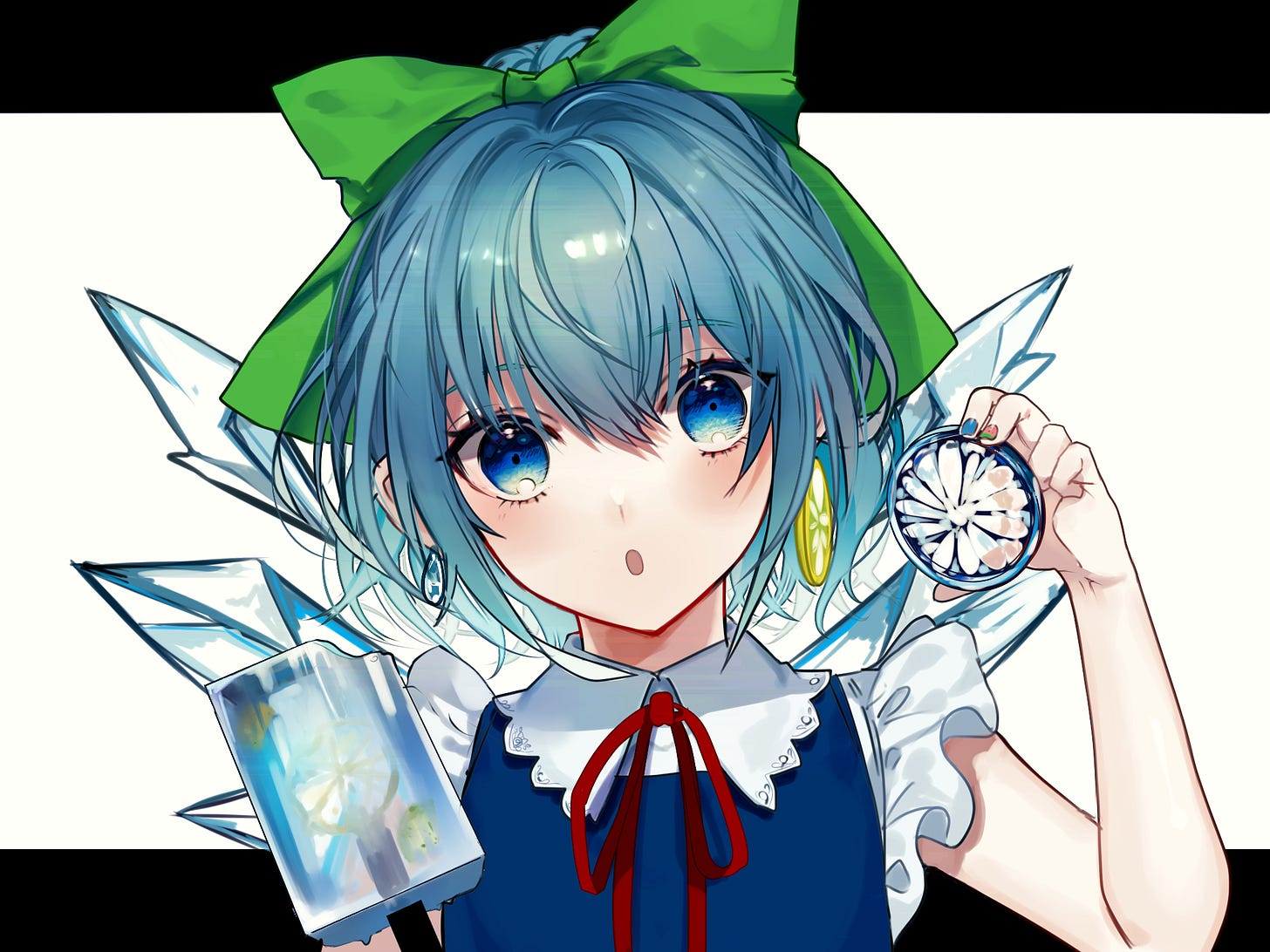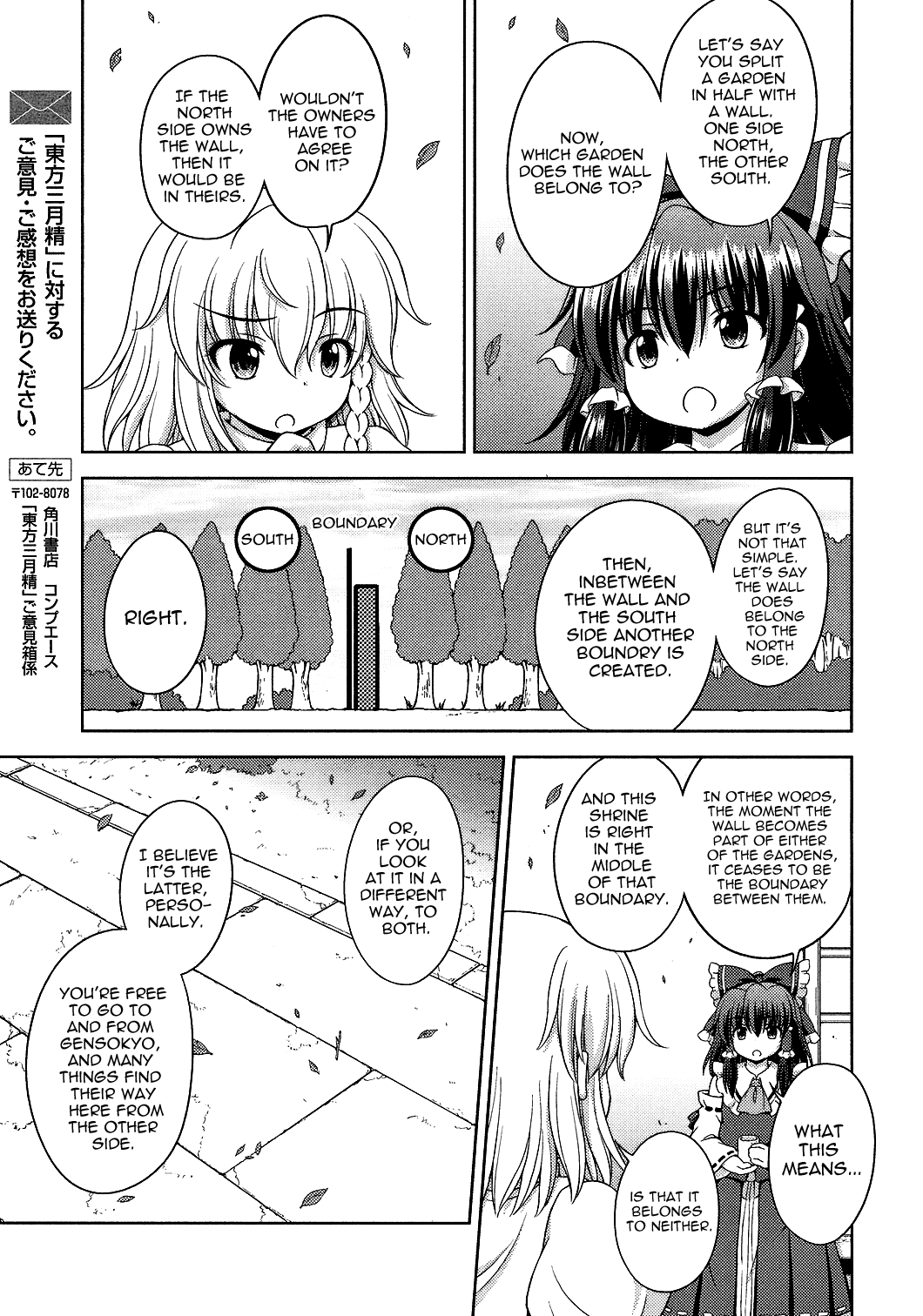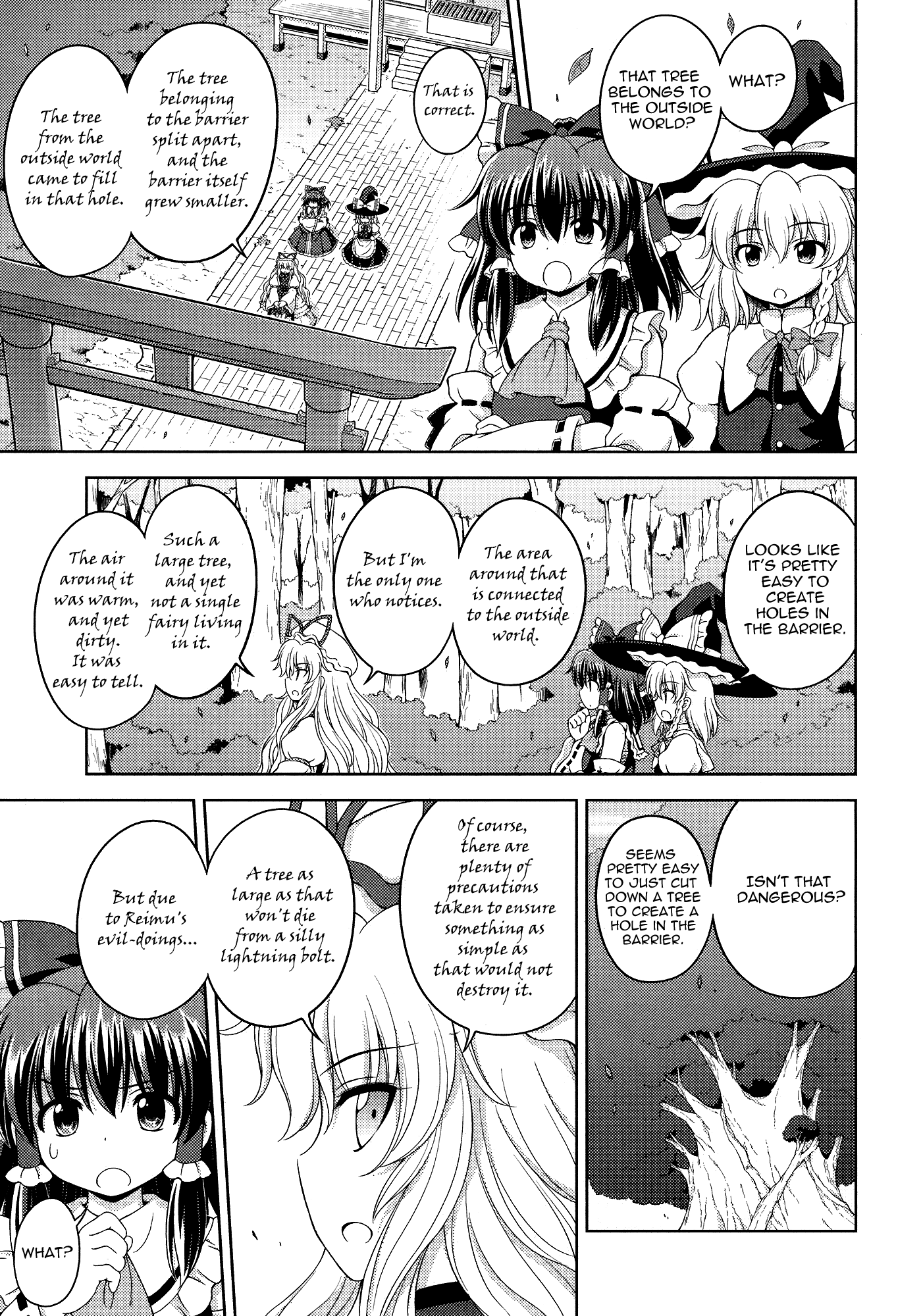Cirno's Perfect Theology Class
What Touhou Project teaches us about religion and the universe

It’s another quiet autumn day at Hakurei Shrine—shrine maiden Reimu is sweeping fallen leaves, chatting to her friend Marisa on the porch.
Suddenly Yukari Yakumo, the yōkai of borders, steps out of a tear in space and chucks 2000 yen into the shrine’s offering box. She asks them about a tree behind the shrine that was previously destroyed by lightning but grew back towering over its clearing in a short amount of time. Does Reimu know anything about that?
She doesn’t. Before it was struck by lightning, she started worshipping it, building an altar and leaving offerings but abandoned the idea soon after.
Yukari scolds her.
Gods will inhabit pretty much any object. It may be just a tree, but the moment you start worshipping it, a god starts living in it. The god who inhabited this tree must be rather regretful, after you abandoned it and all.
Later, Yukari approaches Sunny Milk, Luna Child, and Star Sapphire, three mischievous fairies of the forest who are planning to move into the tree. Fairies are spirits of nature and can help living things grow but the trio says they aren’t strong enough to make a tree grow so quickly.
Be that as it may, Yukari is protective of the tree and decides she will test the fairies to determine if they’re fit to live in it.
Meanwhile, Reimu has been thinking about what Yukari said to them. Hakurei Shrine marks the border between the world they live in, Gensōkyō, and the outside world, divided by the Hakurei Boundary. In a way, the shrine belongs to both worlds.
Let’s say you split a garden in half with a wall. One side north, the other south. Now, which garden does the wall belong to? (…) Let’s say the wall does belong to the north side. Then, inbetween the wall and the south side another boundry is created. In other words, the moment the wall becomes part of either of the gardens, it ceases to be the boundary between them. And this shrine is right in the middle of that boundary. What this means is that it belongs to neither. Or, if you look at it in a different way, to both. I believe it’s the latter, personally. You’re free to go to and from Gensokyo, and many things find their way here from the other side.
The tree is “right where the boundary meets”. Could that have something to do with its unusual growth?
The fairies are having trouble escaping Yukari’s onslaught of attacks. They’re not strong so Yukari beats them up with little resistance. Finally she declares that they pass the test—she only wanted to know if they were weak enough to not corrupt the tree with their powers.
Leaving the fairies to celebrate, Yukari returns to Reimu and Marisa to reveal that the current tree came from the outside world after its predecessor was destroyed by lightning. It’s not the same tree!
The tree belonging to the barrier split apart, and the barrier itself grew smaller. The tree from the outside world came to fill in that hole. The area around that is connected to the outside world. (…) Such a large tree, and yet not a single fairy living in it. The air around it was warm, and yet dirty. It was easy to tell.
Usually a tree like that wouldn’t die from a lightning bolt but Reimu weakened it by forgetting to worship it. The moment she started believing in its deity, it started existing—when she stopped, it died off just as quickly.
Living up to her role as wise yōkai elder, Yukari used the fairies to fill the hole in the new tree. As spirits of nature, the fairies are an embodiment of Gensōkyō itself and therefore suitable to fill that hole. After all, it would be bad if anyone could move between Gensōkyō and the outside world (possibly Yukari wants to keep that privilege to herself).
After the fairies come to live in the tree, they are often spotted playing pranks around the shrine. Even fewer visitors come, leaving even less money in the offering box.
The end.
Touhou Project
This story appears in chapters 23 to 25 of Touhou Sangetsusei ~ Strange and Bright Nature Deity, a manga series belonging to the multimedia franchise Touhou Project. I’ve written about the popularity of Touhou Project before.
One big reason why I love Touhou is that it tells stories about belief, religion, and the human relationship to the supernatural through silly and mischievous characters wreaking havoc and getting intro trouble.
Those three chapters from Strange and Bright Nature Deity touch on all these themes, starting with how and why Gensōkyō was created and ending with the relationship between humans and yōkai. Let’s take a closer look.
The Creation Myth
According to Perfect Memento in Strict Sense, Gensōkyō was originally nothing more than a remote spot in the mountains. Around 500 years ago, however, humans were beginning to lose faith in deities and spirits, weakening the yōkai living among them. Yukari Yakumo, yōkai of space and boundaries, decided to create a boundary of illusion and reality around Gensōkyō to give yōkai a place to live that was separate from human reality. And so the land of fantasy was born1.
What strikes me is how Gensōkyō and the Hakurei Boundary are described to differentiate them from the real world. For example, Touhou Bougetsushou ~ Cage in Lunatic Runagate says Gensōkyō exists within the borders of uncommon sense to explain certain events taking place on the backside of the moon.
Gensokyo was separated from the outside world by a border of common sense, and it existed within the borders of uncommon sense.2 To maintain the border as the way it was, everything needed a backside.
Perfect Memento in Strict Sense offers this footnote on the Hakurei Boundary.
It's a boundary of logic, but it is said to have become extremely difficult for humans and youkai alike to pass through it, so it's clearly a strong boundary.
The only place that connects Gensōkyō to the human world is the Hakurei Shrine, residence of shrine maiden protagonist Hakurei Reimu. As mentioned above, Strange and Bright Nature Deity describes it as belonging to both and neither.
Humans and Kami
One core concept of Shintō is that kami live right beside humans. At the same time, sacred space is still marked by shrines, sacred rope and other symbols. Why? In a world where the sacred often looks like the profane, I suppose those symbols help us recognise its dwelling places and avoid being disrespectful (inviting bad luck or curses)3.
Perfect Memento in Strict Sense acknowledges that it is human belief in them that creates and maintains kami.
The powers of the divine spirits come from the power of faith. If they have many believers, they will have a greater influence on humans and youkai, and the shrine will also become greater4. Conversely, when faith decreases, their powers of influence will become weaker, and their shrine will begin to decline.
Humans pray to kami for health, safety, and success—it is easy to imagine that humans in Gensōkyō ask their kami to protect them from the resident yōkai. In other words, humans rely on kami to maintain the order they have established in the spaces they inhabit and to keep the outer world at bay.
Mircea Eliade describes this role of the sacred in The Sacred and the Profane. Traditional societies distinguished between their inhabited territory and the unknown space surrounding it. The former is their world or cosmos, the latter is a foreign, chaotic “other world”, populated by demons, ghosts, “foreigners”.
Whenever these societies settled a new place, they consecrated it by building an altar or temple. This is effectively a transformation from chaos into cosmos, mirroring the primordial act of creation that lies at the core of so many religions and mythologies.
When they tilled the desert soil, they were in fact repeating the act of the gods who had organized chaos by giving it a structure, forms, and norms.5
Kami, specifically the kami revered at Hakurei Shrine, exist to keep the chaos, represented by yōkai and other supernatural beings in Gensōkyō, at bay. But wouldn’t it be more effective to exterminate those supernatural beings altogether?
Humans and Yōkai
Similar to kami and humans, the yōkai and humans of Gensōkyō also form a symbiotic relationship. As explained by Yukari in Cage in Lunatic Runagate, yōkai eat humans but can’t eat all of them because they would starve. Humans, on the other hand, fear yōkai but can’t exterminate them because Gensōkyō was created for yōkai in the first place.
Youkai need to attack people because if they don’t do so, their very existence will be at risk, so youkai will attack humans. The lives of those who live in Gensokyo are maintained by the youkai. If there were no youkai in Gensokyo, Gensokyo would collapse. Thus, humans will not forget the fear that they have for the youkai and yet will not exterminate the youkai that might attack them, since doing so would destroy Gensokyo. The opposite is also true, and if youkai didn’t have any humans to attack, the youkai would lose the meaning of their existence. Thus, youkai may attack humans but do not eat them recklessly. Humans from the town are generally not for their eating under the contract.
You could say that any humans dumb or delusional enough to settle in such a place made their own bed.
What would happen if humans and yōkai were to mix in this environment? We probably don’t want to find out—Reimu at least firmly believes that if a human turned into a yōkai, it would spell the destruction of Gensōkyō6.
Afterword
Touhou Project is a setting born out of humanity’s need for the sacred and supernatural. It helps us distinguish the real from the unreal. Both the sacred and the supernatural play important roles for human society: Humans make sense of the world by separating their ordered territory from the disordered chaotic outside world and clearly defining their borders.
Still, they need to interact with the outside world every now and then to prevent stagnation and decay. Therefore there are touching points that enable communication and exchange between both worlds in Gensōkyō, such as Suzunaan, a bookshop that deals in yōkai books, and Kōrindō, an antique shop led by half-yōkai Morichika Rinnosuke that often buys and sells artifacts from the modern world. At the same time, this communication is monitored by gatekeepers such as Yukari, author of Perfect Memento in Strict Sense Hieda no Akyū, and Reimu herself.
And so humans and yōkai coexist peacefully in Gensōkyō, as humans and the sacred coexist in modern-day Japan and elsewhere… or do they?
Japanese-English translation note: Translations of Touhou Sangetsusei by DamageDesu. Translations of Touhou Bougetsushou by Sabino. Translations of Touhou Suzunaan by Clarste.
The Japanese 幻想郷 literally means “land of illusions” or “land of fantasy”.
幻想郷は外の世界と常識の結界により断絶され、非常識の内側に存在する。 (Cage in Lunatic Runagate, Chapter 5)
Although I wouldn’t be surprised if some Touhou character claimed that shrines were to kami what national parks were to nature: a way to preserve rare or endangered species, to apologise for how humans behaved in the past.
Original footnote: Because monetary offerings will increase.
The Sacred and the Profane, p.31
Touhou Suzunaan ~ Forbidden Scrollery, Chapter 25







